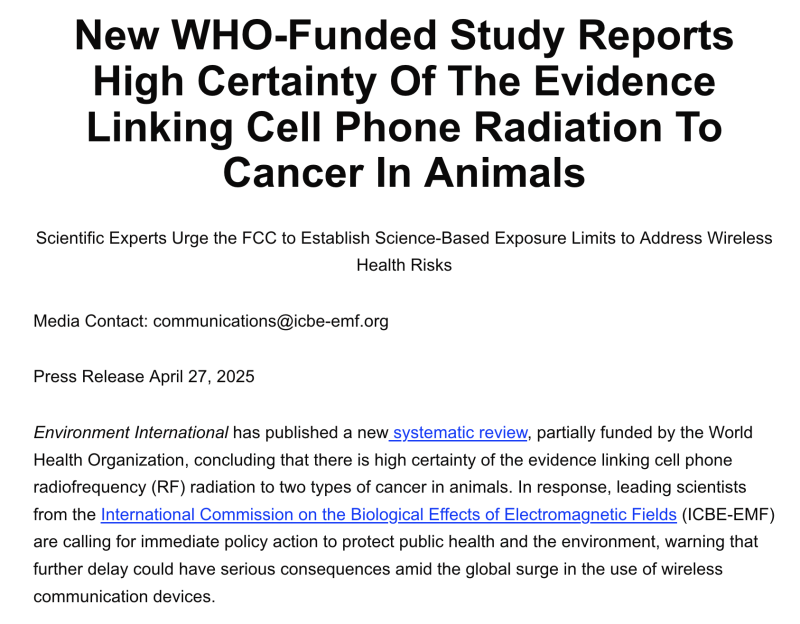Why this matters
On 25 April 2025 Environment International published the most comprehensive, WHO-commissioned review of radio-frequency (RF) animal studies to date. The authors conclude that RF exposure does cause cancer in laboratory animals — a direct challenge to ICNIRP’s “heating-only” guideline and the regulatory limits most countries still apply.
Who did the work?
The systematic review was led by toxicologist Meike Mevissen (University of Bern) with co-chair Kurt Straif (former head of IARC Monographs). The WHO EMF Project funded the protocol and peer-review; the paper runs 75 pages and follows GRADE/OHAT quality scoring.
How the evidence was gathered
-
52 animal studies screened, 20 two-year bioassays included.
-
Risk-of-bias judged “probably or definitely low” for all key findings.
-
Certainty of evidence (CoE) graded High, Moderate or Low for each tumour site.
Headline findings you can quote
| Tumour site (species/sex) | Certainty | Lowest SAR with effect | Key studies |
|---|---|---|---|
| Malignant heart schwannoma (male rats) | High | 0.1 W kg⁻¹ (whole-body) | Ramazzini (0.1 W kg⁻¹) + NTP (trend up to 6 W kg⁻¹) |
| Brain glioma (male rats) | High | 0.16 W kg⁻¹ (trend); clear at 6 W kg⁻¹ | Anderson 2004, NTP 2018 |
| Adrenal pheochromocytoma | Moderate | 1.5 W kg⁻¹ | NTP 2018 rats |
| Liver hepatoblastoma | Moderate | 5 W kg⁻¹ | NTP 2018 mice |
| Lymphoma | Moderate | 2.5 W kg⁻¹ | NTP 2018 mice (females) |
| Lung bronchio-alveolar tumours | Moderate (trend) | 2.5 – 10 W kg⁻¹ | NTP 2018 mice + two promotion studies |
“There is evidence that RF-EMF exposure increases the incidence of cancer in experimental animals, with the certainty strongest for malignant heart schwannomas and gliomas.”
Why this up-ends the “only heating harms” story
-
All high-certainty tumours occurred without exceeding core-temperature thresholds the authors monitored to rule out thermal artefacts.
-
Oxidative-stress pathways and calcium-channel dysregulation are flagged as plausible non-thermal mechanisms, echoing hundreds of cellular studies.
-
The two tumour types with High CoE in animals match the very tumours (glioma, acoustic/vestibular schwannoma) already reported in heavy mobile-phone users, strengthening biological relevance.
Policy and business implications
-
Standards must move beyond SAR-heating: The review shows effects at 0.1 W kg⁻¹ — 40× below ICNIRP’s whole-body limit.
-
Advocacy talking points:
-
Push regulators to adopt science-based, non-thermal limits and to revisit outdated FCC/ICNIRP guidelines.
-
Support the International Commission on the Biological Effects of Electromagnetic Fields (ICBE-EMF) call for immediate exposure-limit reform (27 Apr 2025 press release).
-
-
Consumer guidance: Encourage keeping phones off-body, speaker / air-tube use, wired networking at home, and demand Li-Fi/optical alternatives in schools.
“A WHO-funded mega-review of 52 animal studies now confirms what many smaller studies have hinted: everyday wireless radiation can trigger the same deadly heart and brain tumours in lab rats that we’re seeing in long-term phone users. Waiting for bodies to pile up before tightening safety limits is not an option.”
Full citation
Mevissen M. et al. “Effects of radio-frequency electromagnetic field exposure on cancer in laboratory animal studies: a systematic review.” Environment International (25 Apr 2025) DOI:10.1016/j.envint.2025.109482.








